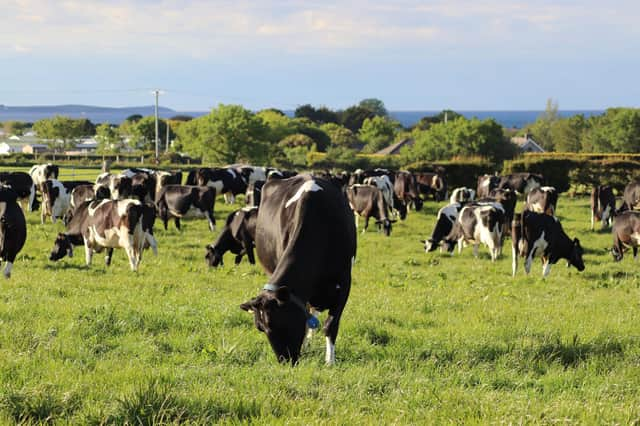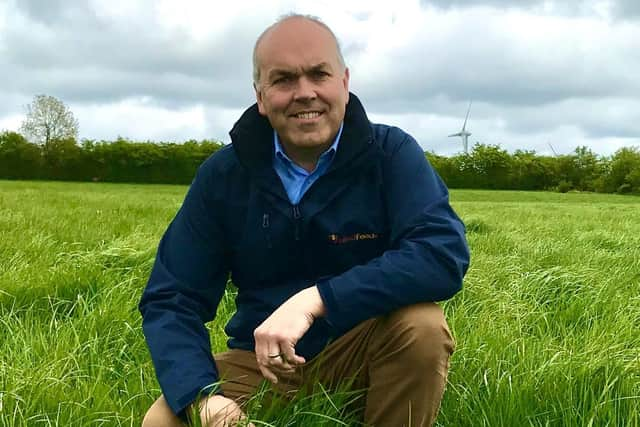Silage fears – help available for NI farmers


Coping with extremes could best describe the challenges that have faced producers since turnout.
The month of April was characterised by cool conditions, but growth rates were sufficiently strong to allow most farmers to establish a grazing wedge.
However, an intense burst of growth during the first two weeks of May has seen many dairy farmers struggling to keep on top of grass quality in mixed weather conditions.


Rapid growth brings with it the direct benefit of enhanced production levels. But the downside to all of this is the accompanying acceleration in grass maturity levels.
Despite the push made by many farmers to take out surplus grazing areas and paddocks as silage over the past number of weeks, they were still left in the position of pushing cows through swards that were excessively mature, from a grazing point of view.
Energy fears
And this process is continuing. Members of the United Feeds’ ruminant nutrition advisory team have walked paddocks over recent weeks with grass Metabolisable Energy (ME) values averaging 10.7 MJ/kg DM.
This is well below the levels one would expect for the month of June. In fact, it is well below the desired energy for grass silage. This is inevitably leading to an energy deficit which is reflected currently in reduced milk yield, depressed milk solids (particularly milk protein) and a loss of body condition in many herds.
Cows grazing heavy swards of mature grass will leave higher than desirable residual covers leading to slower regrowth and poorer quality swards.
There is also strong evidence to confirm that the predicted GrassCheck value of grass figures do not reflect the situation occurring on individual farms across Northern Ireland. The current GrassCheck predicted value of grass projects a milk yield from grazed grass of maintenance plus approximately 17 litres being achievable.
However, the figures published are based on theoretical dry matter intakes. Recent grassland assessment by United Feeds’ advisors has shown large variations in grass intakes across the country depending on local weather, growing, and grazing conditions. The only way for farmers to know what is happening in their own individual circumstances is to get out, walk their grassland areas and accurately assess sward growth rates and actual grass intakes. Only then can a true “maintenance plus” figure be calculated and an accurate concentrate supplementation plan be implemented.
Help available
For those producers who are not totally confident of accurately assessing daily grass growth rates and grass intakes, members of the United Feeds team are always available to provide advice.
As May progressed, the rains continued with a fair degree of vigour. This development also led to an east:west split in terms of ground and grazing conditions.
In order to prevent poaching, a significant number of producers made the decision to keep cows in at night. However, this had the knock-on effect of further dissuading cows from pushing through what had become, in many cases, quite mature grazing swards.
Recent days have seen daily grass growth rates returning to more normal levels of 60-70kg of dry matter (DM)/ha/day.
This is good news. However, it is crucially important that all swards are assessed on a regular basis to accurately determine daily growth rates. Only in this way can decisions be taken that allow grazing resources to be put to best use over the coming weeks.
Crucial decisions
Timing, in this regard, is of the essence. Unless proper management decisions are taken now, the opportunity to maximise the value of grazed grass in milk production systems may well be forgone for the rest of the 2022 season.
Some options to improve grass utilisation and intakes in the days and weeks ahead are to consider pre-mowing of grazing paddocks; take out heavier, poor-quality swards, top paddocks after each grazing and introduce better quality silage aftermaths.
The silage year that is 2022 has thrown up some very counter-intuitive results. Even though many farmers reduced fertiliser applications rates, yields in the pit are well ahead of what would be regarded as normal values.
But, not surprisingly, on early assessment of some first cuts, ME and protein values appear to be well down, year-on-year.
There’s little doubt that the weather conditions of the past six months have contributed to this scenario. Swards continued to grow through what was a very mild winter. As a consequence, they got off to the best possible start, once the spring of 2022 eventually arrived.
As first cuts appear to be lower than average quality, it is key that farmers aim for a high quality second cut, particularly aiming for a higher protein crop. Despite high fertiliser costs, it is important to ensure that adequate slurry and fertiliser is applied to meet crop requirements.
If this approach is not taken, second and subsequent silage cuts will not be fit for purpose. Grass needs its requirement for nitrogen, potash and sulphur to be met in full if both forage yields and quality are to be met.
The fertiliser requirements of grazing swards should also be reviewed in the same light. Again, the law of diminishing returns will come into play on those farms where the decision was taken to reduce spring applications or, in some cases, not to put on chemical fertiliser at all.
If you would like assistance with assessment of grazing covers and accurate measurement of sward potential, please contact your local United Feeds’ advisor – find out more at www.ufeeds.com